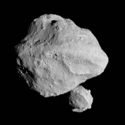2020 MK53
Appearance
| DiscoveryMPS 1836391 | |
|---|---|
| Discovered by | New Horizons KBO Search-Subaru |
| Discovery site | Subaru |
| Discovery date | 22 June 2020 |
| Designations | |
| 2020 MK53 | |
| TNO[1] · SDO · distant[2] | |
| Orbital characteristics[2] | |
| Epoch 24 June 2020 (JD 2459024.5) | |
| Uncertainty parameter 9 | |
| Observation arc | 3 days[3] |
| Aphelion | 160 AU |
| Perihelion | 63 AU |
| 111 AU | |
| Eccentricity | 0.44 |
| 1174 yr | |
| 182° | |
| 0° 0m 2.88s / day | |
| Inclination | 18° |
| 116° | |
| 351° | |
| Physical characteristics | |
| 600–500 km (est. 0.1–0.2)[4] | |
| 25.6 | |
| 4.12[2] | |
2020 MK53 is a trans-Neptunian object in the scattered disc, around 550 kilometres (340 miles) in diameter. It was discovered on 22 June 2020 by the New Horizons KBO Search-Subaru survey[5][6] using the 8.2-meter Subaru Telescope of the Mauna Kea Observatories in Hawaii, and announced on 7 April 2023 (MPS 1836391, MPO 735634). It was 160 astronomical units from the Sun when it was discovered, making it the farthest known Solar System object from the Sun as of September 2023[update], well ahead of 2018 VG18 (124 AU) and 2018 AG37 (~132 AU).[2][7] Given its very short data-arc the only reliable information is in its range (156±4 AU) and range-rate (−0.04 km/s), which suggests that it is close to its aphelion.[8]
References
[edit]- ^ "JPL Small-Body Database Browser: (2020 MK53)" (2020-06-25 last obs.). Jet Propulsion Laboratory. Retrieved 9 September 2023.
- ^ a b c d "2020 MK53". Minor Planet Center. International Astronomical Union. Retrieved 9 September 2023.
- ^ "Distant objects". Minor Planet Center. International Astronomical Union. Retrieved 10 September 2023.
- ^ "Asteroid Size Estimator". Center for Near Earth Object Studies. Jet Propulsion Laboratory. Retrieved 31 May 2022.
- ^ "Subaru Telescope and New Horizons Explore the Outer Solar System". Subaru Telescope. Retrieved 10 September 2023.
- ^ "New Horizons Team Adds AI Smarts to Its Kuiper Belt Object Search". NASA/Johns Hopkins APL/Southwest Research Institute/Subaru Telescope. National Aeronautics and Space Administration. 6 March 2023. Retrieved 10 September 2023.
- ^ "JPL Horizons On-Line Ephemeris for 2020 MK53". JPL Horizons On-Line Ephemeris System. Jet Propulsion Laboratory. Retrieved 9 September 2023. Ephemeris Type: VECTORS, Target Body: Asteroid (2020 MK53)
- ^ C. de la Fuente Marcos & R. de la Fuente Marcos (1 January 2024). "Past the outer rim, into the unknown: structures beyond the Kuiper Cliff". Monthly Notices of the Royal Astronomical Society Letters. 527 (1): L110 – L114. arXiv:2309.03885. Bibcode:2024MNRAS.527L.110D. doi:10.1093/mnrasl/slad132. Retrieved 28 September 2023.
External links
[edit]- 2020 MK53 at AstDyS-2, Asteroids—Dynamic Site
- 2020 MK53 at the JPL Small-Body Database


